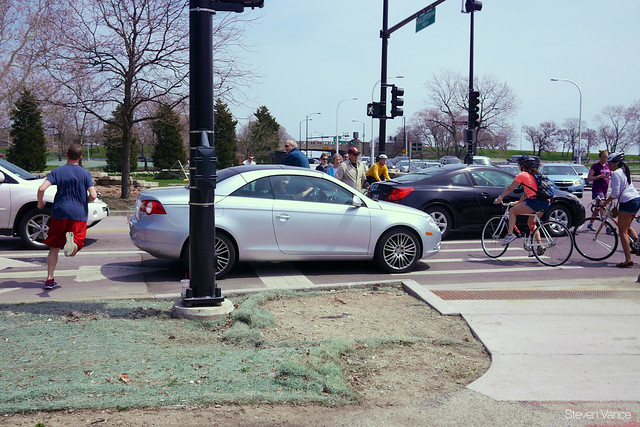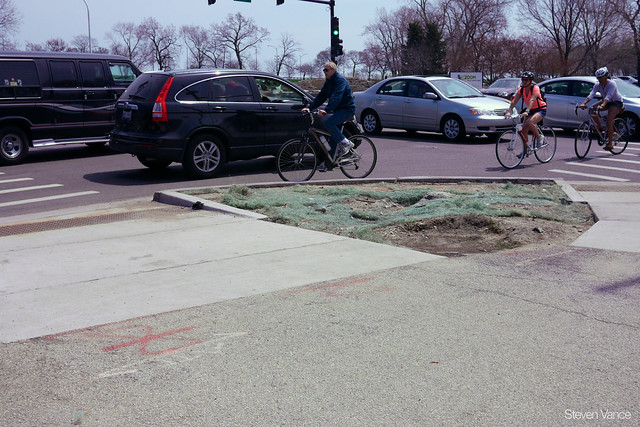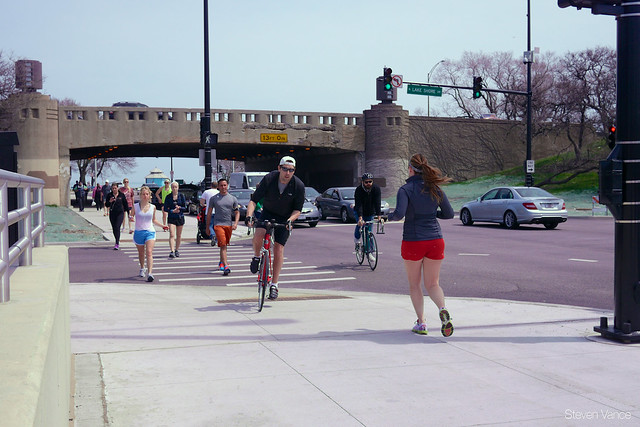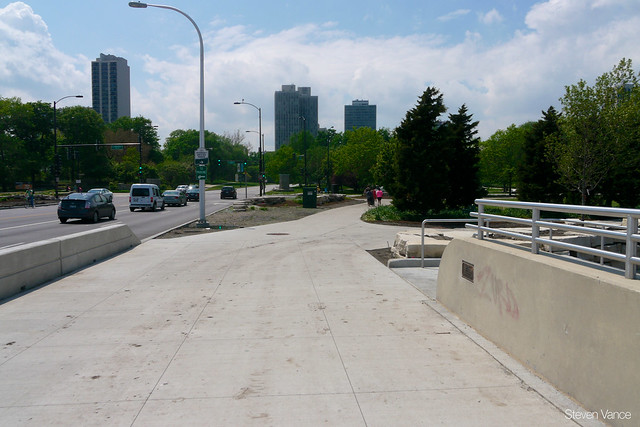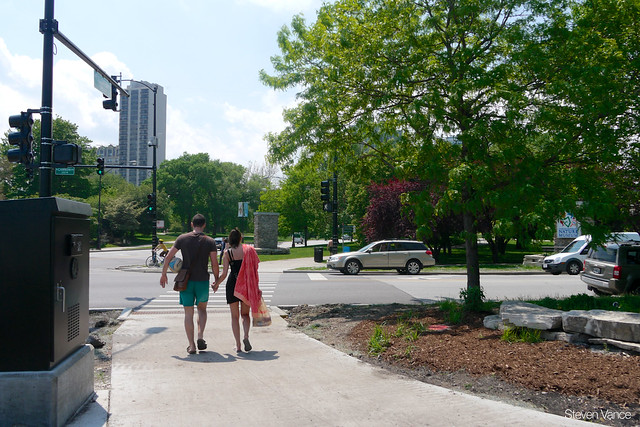Last year the Chicago Department of Transportation reconfigured Fullerton Avenue between Cannon Drive and the lakefront to make it easier for cars to enter southbound Lake Shore Drive, at the expense of pedestrians and bicyclists. To make room for a dedicated right-turn lane and a second on-ramp lane, CDOT eliminated the south sidewalk of Fullerton, which previously served as a safe (just 2 bike crashes and 0 pedestrian crashes from 2005-2011), direct route for people on foot and bikes (since it was a de-facto multiuse path) heading east to the Lakefront Trail.
Walkers and bikers heading to the lake now have the option of crossing to the north side of Fullerton in a crosswalk west of Cannon, walking east across Cannon, and then proceeding east to the beach on the north sidewalk, which has been widened to 20 feet. The wider sidewalk is an improvement over the old 13.5-foot sidewalk on the north side, but it only reclaims about half the space that was taken from pedestrians when the 13.5-foot sidewalk on the south side was eliminated.
Alternately, from the southwest corner of Fullerton/Cannon, walkers and bicyclists can proceed east across Cannon and use a very circuitous, ramps-and-underpass route to the north sidewalk. A third option for cyclists is to pedal east in the street, but this is dangerous because there are now two lanes of cars turning south onto LSD. Other changes include the removal of the crosswalk from the eastern leg of Fullerton/Cannon, and the creation of two left-turn lanes for southbound drivers on Cannon turning east onto Fullerton.
The new configuration was designed during the Richard M. Daley administration, back when the city's complete streets policy consisted of a single sentence. It would fail to meet several of the standards of CDOT's Complete Streets Chicago design guide, which was released in April.
Confusing and counterintuitive
People 12 and older are usually required to bike in the street, but in this case it's unsafe to pedal east to the lakefront on Fullerton, and cyclists and pedestrians are now expected to use the north sidewalk. There's a learning curve to figuring out the intended at-grade and underpass routes. During the time it takes to learn the new setup, people will encounter obstacles and break the rules through no fault of their own. They're walking and biking east on the south sidewalk of Fullerton Avenue to access the Lakefront Trail only to discover that the sidewalk disappears east of Cannon. At that point, I witnessed several people cross Fullerton in the east leg of Fullerton/Cannon, which is unsafe because there is no crosswalk, but much more direct than the ramps-and-tunnel route.
Not enough room for non-motorized traffic
While the north sidewalk of Fullerton is 20-feet-wide where it crosses the canal, which seems to be sufficient for bike and ped traffic, the crosswalk and sidewalks at Fullerton/Cannon are too narrow. Actually, all of the sidewalks that lead to this intersection are too narrow.
Where Fullerton's north sidewalk intersects with LSD's southbound exit ramp, the curb ramps are much narrower than the sidewalk, funneling walkers, joggers and bicyclists into a narrow opening, which increases the potential for conflicts between slow and fast non-motorized traffic.
Everyone wants to use the curb ramps because it's an easier than stepping off the curb, but everyone on bicycles or with baby strollers needs to use the curb ramp.
Cars still on top
In addition to all of the problems outlined above, there's a fourth way the new intersection/corridor design "improves" the situation for driving.
The design encourages speeding with wide turning radii for drivers entering and exiting Cannon Drive north of Fullerton, and with a well-timed green light for drivers turning from Cannon onto Fullerton towards Lake Shore Drive.
This intersection doesn't have a leading pedestrian interval, which contributes to the danger of turning drivers not yielding right-of-way to pedestrians - a common danger throughout Chicago. The amount of signal time for pedestrians and cyclists cross is low relative to the amount of non-motorized traffic here.
Some of these problems can still be fixed. For example, the signals can be re-timed with a leading pedestrian interval to let walkers and cyclists start crossing before a right-turning driver cuts them off. CDOT could also add a "pedestrian scramble" signal phase here to increase safety and convenience for people on foot and bikes. Other issues can't be addressed without reconstructing the road. For example, providing a safe place for people to bike on Fullerton would require reconstructing the roadway to create a curbside bike lane with a bike-only signal at the Lake Shore Drive entrance ramp. The status quo is a completely unsatisfactory.
